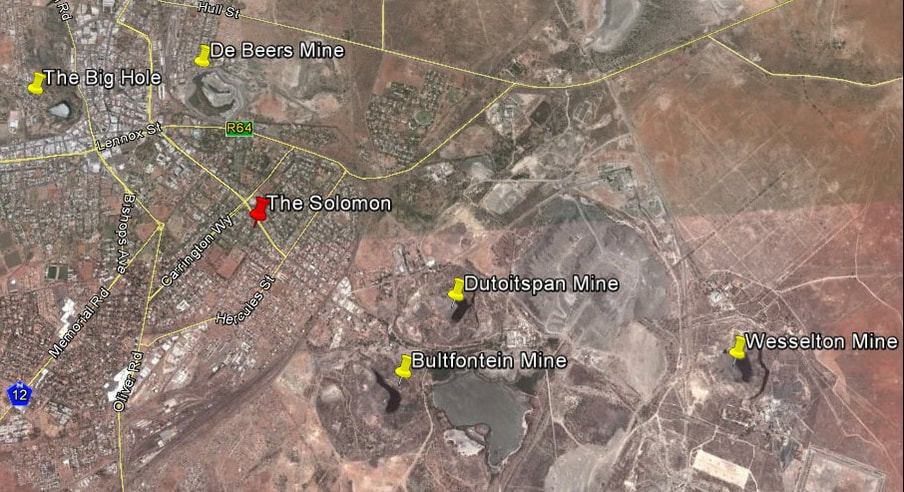Kimberley is the original Diamond City. It is the capital of the Northern Cape province, located in Sol Plaatje Local Municipality in the Frances Baard District. Lacking the furious pace of South Africa’s urban giants, the Victorian & Edwardian grandeur of stately buildings complement the more modern buildings. With a population of just over 225,000, it is a quiet yet thriving city.
Colonial beginnings
In 1871, five years after the finding of a diamond further south on the banks of the Orange River near Hopetown, the De Beers brothers gave Dutch diamond-prospectors permission to dig on their small farm. An 83.5 carat diamond was found on the slopes of the small Colesberg Kopje (hill), which led to the biggest diamond rush into the area. As miners arrived in their thousands, the digger camp of "New Rush" rose from the dust. In 1873 it was re-named Kimberley after John Wodehouse, 1st Earl of Kimberley and British secretary of State for Colonies. Colesberg Kopje soon became an indentation and then a large crater - this is the Kimberley diamond mine or "Big Hole", which you can visit today at the recently upgraded and exciting open-air museum.
Galeshewe township
Galeshewe, the main township that adjoins Kimberley, was originally built under the colonial laws to house the area's African population and is still largely populated by African people. The township's existence dates from 1871 and for many years it was known as Number Two Location, until 1952 when it was named after Chief Galeshewe of the Batlhaping tribe. He was an important figure to the local African population and spent many years in jail after he rebelled against the Cape Colony Government several times to protect his people.
A City of Great Innovation
- The Kimberley Club on Du Toitspan Road was established in August 1881. Among its more illustrious past members, it counts Cecil Rhodes, Leander Starr Jameson, Charles Dunnell Rudd, Barney Barnato, Sir Ernest Oppenheimer and Harry Oppenheimer.
- Kimberley was the home of South Africa's first stock exchange. Situated in Ebden Street, it was officially opened on 2 February 1881 by mayor Moses Cornwall. The exchange quickly became too small for all the business which was being conducted there. In December 1882 the exchange was gutted by fire and the offices moved to the Craven Hotel as a temporary solution. The architect Robert Day designed a new exchange which opened on the corner of Christian and Church Streets. The boom was short-lived and by the time the building was completed very few transactions were taking place. The exchange finally ceased operations in March 1894 and the company was liquidated in 1903. The building was used as a town hall in 1898, during the siege it housed displaced persons, later it was used by the Ohlsson’s Brewery until it was demolished in the 1950s.
- In September 1882 Kimberley was renowned as the first town in the southern hemisphere to install electric street lighting. Some of these earliest lights can still be seen outside the City Hall.
- The rising importance of Kimberley in the late 1800s led to one of the earliest International Exhibitions in the southern hemisphere to be staged here in 1892. Opened on the 8th of September by Sir Henry Loch, Governor of the Cape of Good Hope, it presented exhibits of art, including paintings from the royal collection of Queen Victoria, as well as mining machinery and other implements.
- South Africa's first School of Mines opened in Kimberley in 1896, later relocating to Johannesburg.
- General van der Spuy Drive is the location of South Africa’s first Flying School. Started in 1913, pilots of the South African Aviation Corps, later the South African Air Force, were trained here. A replica of the Compton Paterson trainer biplane is on view at the Pioneers of Aviation Museum.
Kimberley City Hall
The original Town Hall was made of tin. It was where Jan Smuts made his inaugural speech in 1895. Today, the elegant cream and white City Hall is built in Roman Corinthian style. Situated on the corner of Old Main Street and Phakamile Mabija Road (formerly Jones Street) in the city centre, it dates from 1899, just before the the Siege of Kimberley at the start of the 2nd South African War (the Anglo-Boer War - 1899-1902). This combination of elegance and superior workmanship was designed by architect, Fergus Carstairs Rogers (1864-1927) who was educated at Dollar Academy and George Watson's School (Edinburgh, Scotland). He went to London before emigrating to Kimberley where he commenced independent practice in 1892.
Anglo-Boer War
On 14 October 1899, Kimberley was besieged at the beginning of the 2nd South African War (Anglo-Boer War - 1899-1902). The siege was only lifted on 15 February 1900, but the war continued until May 1902. By that time the British had built one of the first concentration camps at Kimberley to house Afrikaner women and children of the Boers (farmers). The museum at the Magersfontein Battlefield gives a real insight into how horrific this war must have been. The Honoured Dead Memorial at the crossroads of Dalham & Oliver Roads was designed by Sir Herbert Baker and built at the behest Cecil Rhodes to honour those who died defending Kimberley during the siege. ‘Long Cecil’, the field gun made and used during the siege of Kimberley, is mounted on the stylobate surrounded by shells from the Boer ‘Long Tom’. Built of Zimbabwean sandstone, it bears an inscription by Rudyard Kipling and bronze plaques by Kipling’s father.
Museums & Galleries
- Digging commenced at the Kimberley mine site in 1871. By the time mining ended on 14 August 1914, the mine had yielded 2,722 kilograms of diamonds, extracted from 22.5 million tons of excavated earth. Today what remains is a massive crater 214 meters deep with a surface area of 17 hectares and a perimeter of 1.6 km. It is surrounded by original buildings from the heyday of the mine, relocated from earlier sites to form an unforgettable open air visitor experience. Through an investment by De Beers Consolidated Mines, numerous attractions have been added to the Big Hole Mine Museum - a world-class tourist destination, providing unique insights into diamonds, diamond mining and the process of recovering rough diamonds right through to the polished gem found in today’s jewellery.
- The renowned McGregor Museum is housed in the Sanatorium on Atlas Street. The Sanatorium was built in 1897 at Cecil Rhodes’ instigation as a hotel and health resort, becoming his home during the four-month siege of Kimberley. Displays include natural history, the Siege of Kimberley, a Hall of Religions and the acclaimed Ancestors Gallery, depicting 3 million years of human history in the Northern Cape.
- The Alexander McGregor Memorial Museum in Chapel Street is the original Museum built in 1907 in memory of the former mayor. Today, as a satellite of the McGregor Museum, it houses displays on Kimberley’s suburban and township development.
- Dunluce (10 Lodge Rd, Belgravia, Kimberley) is one of the city's most elegant houses. Designed by the architect DW Greatbatch and built at the end of the 19th century, it was the residence of the merchant John Orr, whose family stayed there until 1975. The house was then bought by the McGregor Museum, with all its furniture, kitchen utensils, linen, books and photographs - some dating back to 1902 when the Orr family moved into the house.
- Rudd House (5 Loch Road, Belgravia, Kimberley) was built on Plot 931, following a relatively simple design, during the late 1880’s. Known as ‘The Bungalow’, it originally had only four rooms. In 1888 the property was occupied by William Henry Solomon. It changed hands in 1896 when 'The Bungalow' was transferred to Charles Dunnel Rudd.
- The Duggan-Cronin Gallery in Egerton Road depicts indigenous African people before the Western influence could drastically change their own traditional lifestyles. It houses some 8,000 photographs taken by Irishman Alfred Duggan-Cronin between 1919 and 1939.
- The Wonderwerk Cave on the road to Kuruman runs horizontally for 139m into the base of the hill. Different dating methods have shown that the very lowest levels range back to more than 800,000 years ago. Archaeological excavations showed that all of these layers contain stone artefacts (tools) which indicate that people lived in the cave over the entire period.
- The Africana Library in Du Toitspan Road houses missionary Robert Moffat’s personal copy of his Setswana translation of the Bible. This library is a rich repository of books, manuscripts and photographs portraying life in the Northern Cape.
- With over 400 rock engravings, the Wildebeest Kuil Rock Art Centre on the road to Barkly West is one of South Africa’s premier Khoisan rock art sites.
- The William Humphreys Art Gallery (WHAG) at the Civic Centre on Jan Smuts Boulevard is one of the most important galleries in the country. It houses a range of South African works, as well as 16th and 17th century British, Flemish and Dutch Old Masters.
- The Magersfontein Battlefield museum is about 30km south of Kimberley. Its original gun positions, trenches and other defences intact, it is the site of General Piet Cronje’s crushing defeat of Lieutenant-General Lord Methuen, leading a British relief column to the besieged Kimberley. Today the museum displays uniforms, equipment, weapons, documents and photographs from both armies, together with an intense audio-visual experience, bringing one of the 2nd South African War’s most important and decisive battles back to life.
Other Tourist Attractions
The Northern Cape Legislature building in Kimberley was opened in February 2003 by then Deputy President Jacob Zuma and Premier Manne Dipicio. It is a truly inspiring work of art in terms of the creativity that has been unleashed in its construction and is a must-see for locals and tourists alike.
Kimberley is proud to be one of the most authentic historical destinations in South Africa. With this in mind we have grouped together various attractions, for your convenience, in short and interesting tourist walks and routes, built around themes which are exclusive and unique to Kimberley.
Kimberley is proud to be one of the most authentic historical destinations in South Africa. With this in mind we have grouped together various attractions, for your convenience, in short and interesting tourist walks and routes, built around themes which are exclusive and unique to Kimberley.
Today in History
From the Today in History page you can select any date in the year to find out what happened on that day in history in Kimberley and South Africa
©2024 Solomon Edwardian Guest House, 1 Solomon Street, Klisser, Kimberley
Cancellation Policy: All banking fees are not refundable.
If cancelling 7 days or less before arrival, forfeit 100% of the booking price
If cancelling 8-14 days before arrival, forfeit 50% of the booking price
Image copyright: we have not been able to identify the owner of all images used in a not-for-profit basis on this website. If you are the owner please let us know so that we can acknowledge you or remove the image.
Cancellation Policy: All banking fees are not refundable.
If cancelling 7 days or less before arrival, forfeit 100% of the booking price
If cancelling 8-14 days before arrival, forfeit 50% of the booking price
Image copyright: we have not been able to identify the owner of all images used in a not-for-profit basis on this website. If you are the owner please let us know so that we can acknowledge you or remove the image.

